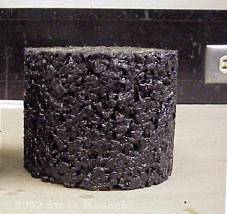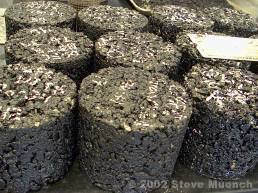HMA Mix Types
The most common type of flexible pavement surfacing in the U.S. is hot mix asphalt (HMA). Hot mix asphalt is known by many different names such as hot mix, asphalt concrete (AC or ACP), asphalt, blacktop or bitumen. For clarity, this Guide makes a conscious effort to consistently refer to this material as HMA. HMA is distinguished by its design and production methods (as described in this Guide) and includes traditional dense-graded mixes as well as stone matrix asphalt (SMA) and various open-graded HMAs. Typically agencies consider other types of asphalt-based pavement surfaces such as fog seals, slurry seals and BSTs to be maintenance treatments and are therefore covered in the Maintenance & Rehabilitation section. Reclaimed asphalt pavement (RAP) is generally considered a material within HMA, while forms of in-place recycling are considered separately. HMA can also be produced at lower than typical production temperatures (290 to 320°F) and is then categorized as Warm Mix Asphalt (WMA). WMA (see Sustainable Pavements page) can be produced using a variety of methods (e.g. asphalt foaming kits at the plant & chemical or wax-based additives) to reduce production temperatures by 15 to 50°F while maintaining or even increasing the time available to compact the mix. WMA is interchangeable with HMA in most paving applications.
Dense-Graded Mixes
A dense-graded mix (Figure 1) is a well-graded HMA intended for general use. When properly designed and constructed, a dense-graded mix is relatively impermeable. Dense-graded mixes are generally referred to by their nominal maximum aggregate size. They can further be classified as either fine-graded or coarse-graded. Fine-graded mixes have more fine and sand sized particles than coarse-graded mixes. Dense-graded mixes are used extensively in Washington State for all purposes.

Figure 1: Dense-Graded Pavement
| Purpose: | Suitable for all pavement layers and for all traffic conditions. They work well for structural, friction, leveling and patching needs. | ||
| Materials: | Well-graded aggregate, asphalt binder (with or without modifiers), RAP | ||
| Other Info: | Particulars about dense-graded HMA are covered by the rest of this Guide. |
Stone Matrix Asphalt (SMA)
Stone matrix asphalt (SMA), sometimes called stone mastic asphalt, is a gap-graded HMA originally developed in Europe to maximize rutting resistance and durability (Figure 2 and 3). The mix goal is to create stone-on-stone contact. Since aggregates do not deform as much as asphalt binder under load, this stone-on-stone contact greatly reduces rutting. SMA is generally more expensive than a typical dense-graded HMA because it requires more durable aggregates, higher asphalt content, modified asphalt binder and fibers. In the right situations it should be cost-effective because of its increased rut resistance and improved durability. SMA, has been used in the U.S. since about 1990, although it has only been used in Washington State on several pilot projects.

Figure 2A: SMA Internal Core Surface  Figure 2B: SMA Surface
Figure 2B: SMA Surface

Figure 3: SMA Lab Sample
| Purpose: | Improved rut resistance and durability. SMA is almost exclusively used for surface courses on high volume interstates and U.S. roads. | ||
| Materials: | Gap-graded aggregate, modified asphalt binder, fiber filler | ||
| Other Info: | Other reported SMA benefits include wet weather friction (due to a coarser surface texture) and less severe reflective cracking. Mineral fillers and additives are used to minimize asphalt binder drain-down during construction, increase the amount of asphalt binder used in the mix and to improve mix durability. |
Open-Graded Mixes
Unlike dense-graded mixes and SMA, an open-graded HMA mixture is designed to be water permeable. Open-graded mixes use only crushed stone (or gravel) and a small percentage of manufactured sands. The two most typical open-graded mixes are:
- Open-graded friction course (OGFC). Typically 15 percent air voids and no maximum air voids specified.
- Asphalt treated permeable bases (ATPB). Less stringent specifications than OGFC since it is used only under dense-graded HMA, SMA or PCC for drainage.

Figure 5: OGFC Surface

Figure 6: OGFC Lab Samples
WAPA Pavement Note on Open Graded Mixes
Open-graded friction course (OGFC) is not used widely in Washington State because of its susceptibility to studded tire wear. Tire studs will tend to dislodge aggregate from the mix in the wheelpaths causing a depression typically referred to as studded tire wear. From 2006 through 2009 WSDOT paved three test sections of OGFC to investigate its use as a “quieter pavement” and performance in Washington State. For the most part, these mix designs were taken from Arizona where they have been extensively used.
| Purpose: | OGFC – Used for surface courses only. They reduce tire splash/spray in wet weather and typically result in smoother surfaces than dense-graded HMA. Their high air voids reduce tire-road noise by up to 50-percent (10 dBA) (NAPA, 1995).ATPB – Used as a drainage layer below dense-graded HMA, SMA or PCC. | ||
| Materials: | Aggregate (crushed stone or gravel and manufactured sands), asphalt binder (with modifiers) | ||
| Other Info: | OGFC is more expensive per ton than dense-graded HMA, but the unit weight of the mix when in-place is lower, which partially offsets the higher per-ton cost. The open gradation creates pores in the mix, which are essential to the mix’s proper function. Anything that tends to clog these pores, such as low-speed traffic, excessive dirt on the roadway or deicing sand, can degrade performance. |
Pavement Types



